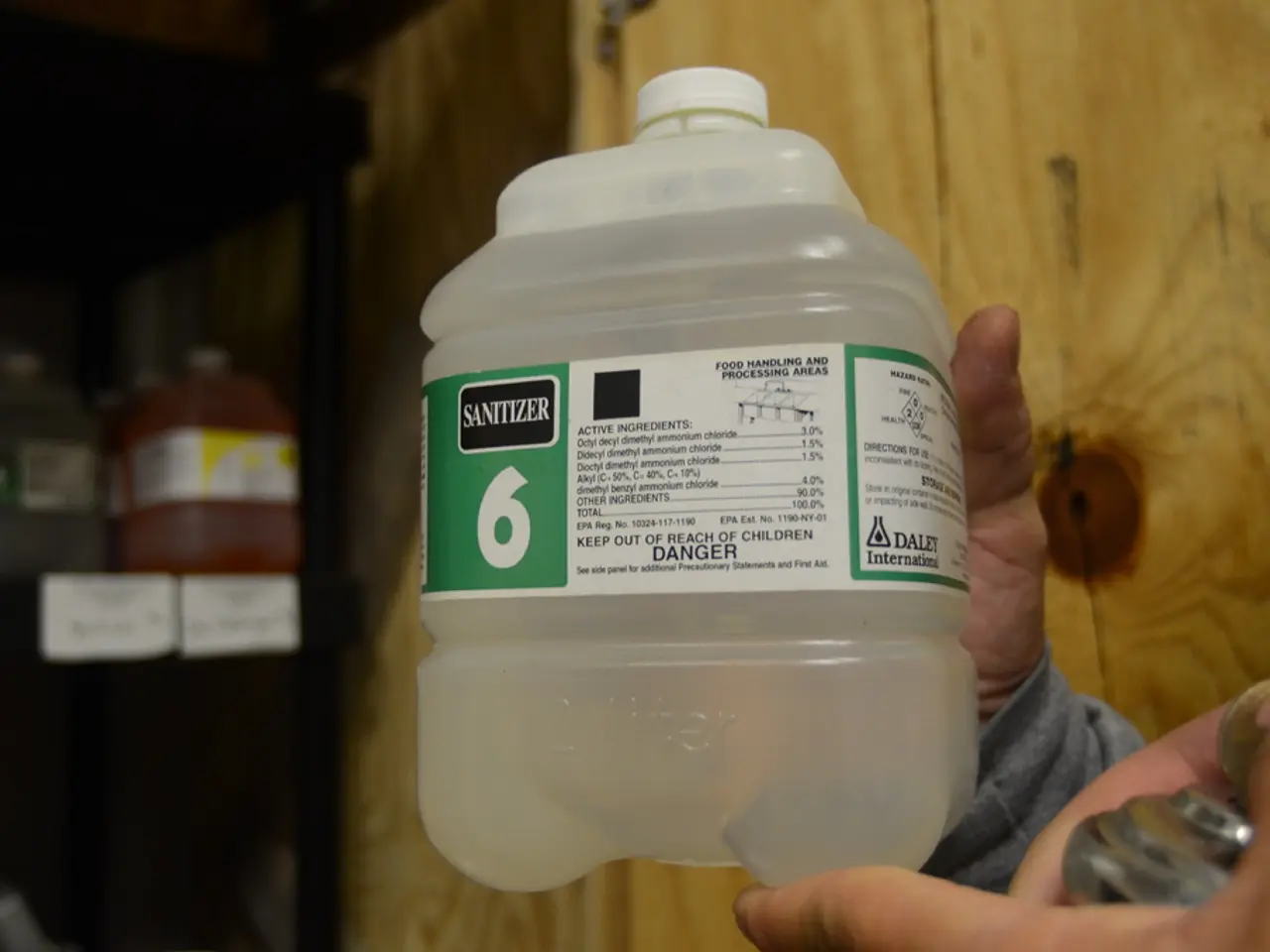Sanitizers: Do They Go Bad Over Time, and What Are the Safety Implications?
In the ongoing battle against germs and viruses, hand sanitizers have become a crucial tool for maintaining good hygiene. Here's a breakdown of what you need to know about these handy products.
Hand sanitizers, when properly formulated and stored, can be highly effective against various pathogens. The World Health Organization recommends formulations containing 60% to 95% alcohol for optimal virucidal activity, including against enveloped viruses such as coronaviruses (SARS, MERS) and influenza viruses.
These sanitizers work by disrupting the viral lipid envelopes, thereby inactivating the viruses. However, as alcohol evaporates over time, the alcohol concentration may drop below the effective threshold of 60%, reducing the sanitizer's ability to reliably inactivate these viruses.
A typical bottle of hand sanitizer retains its effectiveness for about 2 to 3 years, according to the FDA and World Health Organization guidelines. To ensure you're using an effective product, opt for a product with a shelf life of at least 2 years and try to replace any hand sanitizer that expires.
Hand sanitizers can significantly reduce the number of pathogens on the hands when soap and water are not available. The Centers for Disease Control and Prevention (CDC) recommends alcohol-based hand sanitizers containing at least 60% alcohol for optimal effectiveness.
However, it's important to note that soap and water are more effective against certain infectious pathogens than hand sanitizers, such as Cryptosporidium, Clostridioides difficile, norovirus. Soap and water should be used whenever possible.
While expired hand sanitizers may be less effective against certain pathogens, they are still generally safe to use. However, the Food and Drug Administration (FDA) warns against using hand sanitizers manufactured by Eskbiochem SA de CV, as these formulations contain methanol, which is toxic when absorbed through the skin or ingested.
To use hand sanitizer effectively, check the bottle for expiration, apply a generous amount, rub hands together, and allow to air dry. Always remember that hand sanitizers are intended for external use only and swallowing them can cause serious adverse effects, especially in children.
Commercially available hand sanitizers are required to have expiration dates due to regulation. Beyond the expiration date or if alcohol concentration falls below 60%, hand sanitizer may lose the ability to reliably inactivate these viruses, emphasizing the importance of using in-date products for hand hygiene.
In the United States, between 2011 and 2014, a total of 32,342 hand sanitizer ingestions were reported in children younger than 13, with common side effects being vomiting, abdominal pain, a cough, mouth irritation, and eye inflammation.
A 2018 review found that ethanol concentrations of 60% are effective against several viruses, including SARS, MERS, Zika, influenza A and B, herpes simplex viruses 1 and 2, and Ebolavirus. The same review found that ethanol concentrations of 73.6% are effective against the hepatitis C virus, while ethanol concentrations of 40% are not.
Non-alcohol-based hand sanitizers contain the antiseptic benzalkonium chloride. Both types of hand sanitizers also contain water, along with glycerol or other humectants to help prevent skin dryness.
In specific situations, the CDC recommends washing the hands with soap and water: when the hands are visibly dirty, before, during, and after preparing food, before eating food, after using the bathroom, after blowing the nose, coughing, or sneezing, before and after interacting with someone who is sick, before and after treating a cut or wound, after interacting with animals or coming into contact with animal food or waste, and after touching garbage.
In conclusion, hand sanitizers can be a valuable tool for maintaining good hygiene, but it's crucial to use them correctly and responsibly. Always check the expiration date, use a product with at least 60% alcohol, and remember that soap and water are often the best choice when they're available.
- Given the importance of hand sanitizers in fighting germs, understanding their predictive capabilities against various pathogens is essential.
- WHO recommends hand sanitizers with 60% to 95% alcohol for maximum virucidal activity, including against SARS, MERS, and influenza viruses.
- Alcohol in sanitizers works by disrupting viral lipid envelopes, rendering the viruses inactive.
- However, as alcohol evaporates, the sanitizer's efficacy decreases if the concentration drops below the 60% threshold.
- A typical hand sanitizer maintains its effectiveness for approximately 2 to 3 years, as per FDA and WHO guidelines.
- Opt for hand sanitizers with a shelf life of at least 2 years, and replace any expired product.
- Hand sanitizers can significantly reduce pathogens when soap and water are unavailable, recommends the CDC.
- The CDC advises using alcohol-based hand sanitizers with a minimum of 60% alcohol for optimal effectiveness.
- Soap and water are more effective than hand sanitizers against some infectious pathogens like Cryptosporidium, Clostridioides difficile, norovirus.
- Ingesting expired hand sanitizers may be less effective but generally safe, yet the FDA warns against Eskbiochem SA de CV's hand sanitizers containing toxic methanol.
- To use hand sanitizer correctly, check the expiration date, apply generously, rub hands together, and let air dry.
- hand sanitizers are intended for external use only, and consuming them can cause severe side effects, particularly for children.
- Due to regulations, commercially available hand sanitizers come with expiration dates.
- Beyond the expiration date, or if alcohol concentration falls below 60%, hand sanitizer's ability to reliably inactivate viruses diminishes.
- Between 2011 and 2014, 32,342 cases of hand sanitizer ingestion in children under 13 were reported in the US, with common effects being nausea, abdominal pain, coughing, and eye irritation.
- Ethanol concentrations of 60% have proven effective against various viruses, including SARS, MERS, Zika, influenza A and B, herpes simplex viruses 1 and 2, and Ebolavirus.
- Ethanol concentrations of 73.6% have been found effective against the hepatitis C virus, while concentrations of 40% are not.
- Non-alcohol-based hand sanitizers contain the antiseptic benzalkonium chloride, in addition to water, glycerol, or humectants to prevent skin dryness.
- The CDC recommends washing hands with soap and water in specific situations, like handling visible dirt, preparing food, before eating, using the bathroom, after blowing nose, coughing, or sneezing, interacting with sick individuals, treating cuts or wounds, coming into contact with animals or waste, or handling garbage.
- Chronic diseases such as diabetes, COPD, chronic kidney disease, and mental health conditions like bipolar disorder must be managed proactively in the workplace to promote workplace wellness.
- Medical conditions, including cancer, respiratory conditions, digestive health issues, eye health problems, hearing impairments, and neurological disorders, require specialized therapies and treatments.
- Skin care and nutrition are vital in maintaining overall health, especially for managing conditions like psoriasis and autoimmune disorders.
- Fitness and exercise play a crucial role in preventing chronic diseases such as diabetes, cardiovascular diseases, and improving cognitive health, like alzheimers and migraine.
- The renewable energy industry has made significant strides in reducing environmental impact, with manufacturing processes contributing to the generation of clean energy.
- Industries, including manufacturing, retail, transportation, automotive, finance, and real estate, must focus on energy efficiency and sustainable practices.
- In addition to health and wellness, environmental and economic factors contribute to entrepreneurship in industries like oil and gas, public transit, and small businesses.
- Leadership diversity and inclusion are key to fostering an innovative and productive workplace, as noted in the housing market, banking and insurance, fintech, and aviation sectors.
- Commerce encompasses both residential and commercial spaces, playing a crucial role in employing people and contributing to the economy.
- Investing in stocks, mutual funds, bonds, or property involves risk but can offer financial security and growth opportunities for household budgets.
- CBD, used for its potential health benefits, is gaining traction in the market for managing conditions like anxiety, chronic pain, and certain neurological disorders.
- Rheumatoid arthritis, an autoimmune disorder causing joint inflammation, can be managed through medical treatment, lifestyle changes, and expert consultation.







